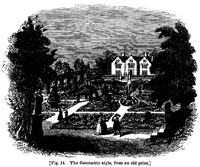The beauties elicited by the ancient style of gardening were those of regularity, symmetry, and the display of labored art. These were attained in a merely mechanical manner, and usually involved little or no theory. The geometrical form and lines of the buildings were only extended and carried out in the garden. In the best classical models, the art of the sculptor conferred dignity and elegance on the garden, by the fine forms of marble vases and statues; in the more intricate and labored specimens of the Dutch school, prevalent in England in the time of William IV. (Fig. 14), the results evince a fertility of odd conceits, rather than the exercise of taste or imagination. Indeed, as, to level ground naturally uneven, or to make an avenue, by planting rows of trees on each side of a broad walk, requires only the simplest perception of the beauty of mathematical forms, so, to lay out a garden in the geometric style, became little more than a formal routine, and it was only after the superior interest of a more natural manner was enforced by men of genius, that natural beauty of expression was recognised, and Landscape Gardening was raised to the rank of a fine art.

